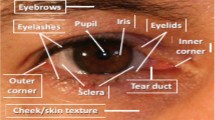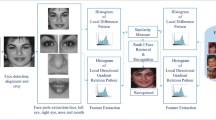Abstract
Huge variation in facial appearances of the same individual makes Age-Invariance Face Recognition (AIFR) task suffer from the misclassification of faces. However, some Age-Invariant Feature Extraction Techniques (AI-FET) for AIFR are emerging to achieve good recognition results. The performance results of these AI-FETs need to be further investigated statistically to avoid being misled. Here, the means between the quantitative results of Principal Component Analysis–Linear Discriminant Analysis (PCA-LDA) and Histogram of Gradient (HoG) are compared using one-way Analysis of Variance (ANOVA). The ANOVA results obtained at 0.05 critical significance level indicate that the results of the HoG and PCA-LDA techniques are statistically well in line because the F-critical value was found to be greater than the value of the calculated F-statistics in all the calculations.
Access this chapter
Tax calculation will be finalised at checkout
Purchases are for personal use only
Similar content being viewed by others
References
Shu C, Ding X, Fang C (2011) Histogram of oriented gradient (HOG) of the oriented gradient for face recognition. Tsinghai Sci Technol 16(2):216–224
Zhifeng L, Dihong G, Xuelong L, Dacheng T (2016) Aging face recognition: a hierarchical learning model based on local patterns selection. IEEE Trans Image Process 25(5):2146–2154
Dihong G, Zhifeng L, Dahua L, Jianzhuang L, Xiaoou T (2013) Hidden factor analysis for age invariant Face Recognition. In: Proceedings of the IEEE international conference on computer vision, pp 2872–2879
Dihong G, Zhifeng L, Dacheng T, Jianzhuang L, Xuelong L (2015) A maximum entropy feature descriptor for age-invariant Face Recognition. In: Proceedings of the IEEE conference on computer vision and pattern recognition, pp 5289–5297
Zhifeng L, Unsang P, Anil KJ (2011) A discriminative model for age invariant face recognition. IEEE Trans Inf Forensics Secur 6(3):1028–1037
Haibin L, Stefano S, Narayanan R, David WJ (2010) Face verification across age progression using discriminative methods. IEEE Trans Inf Forensics Secur 5(1):82–91
Chenfei X, Qihe L, Mao Y (2017) Age invariant FR and retrieval by coupled auto-encoder networks. Neurocomputing 222:62–71
Di H, Mohsen A, Yunhong W, Liming C (2012) 3-D FR using e LBP-based facial description and local feature hybrid matching. IEEE Trans Inf Forensics Secur 7(5):1551–1565
Yulan G, Yinjie L, Li L, Yan W, Mohammed B, Ferdous S (2016) EI3D: Expression-invariant 3D FR based on feature and shape matching. Pattern Recogn Lett 83:403–412
Stefano B, Naoufel W, Albertodel B, Pietro P (2013) Matching 3D face scans using interest points and local histogram descriptors. Comput Graph 37(5):509–525
Stefano B, Naoufel W, Alberto B, Pietro P (2014) Selecting stable key points and local descriptors for person identification using 3D face scans. Vis Comput 30(11):1275–1292
Alexander MB, Michael MB, Ron K (2007) Expression-invariant representations of faces. IEEE Trans Image Process 16(1):188–197
Di H, Caifeng S, Mohsen A, Yunhong W, Liming C (2011) Local binary patterns and its application to facial image analysis. IEEE Trans Syst Man Cybern Part C Appl Rev 41(6):765–781
Kavitha J, Mirnalinee TT (2016) Automatic frontal face reconstruction approach for pose invariant face recognition. Procedia Comput Sci 87:300–305
Goesta HG (1978) In search of a general picture processing operator. Comput Graph Image Process 8(2):155–173
Navneet D, Bill T (2005) Histograms of oriented gradients for human detection. In: IEEE conference on computer vision and pattern recognition (CVPR). San Diego, CA, USA, pp 886–893
Liu CL, Nakashima K, Sako H (2004) Handwritten digit recognition: investigation of normalization and feature extraction techniques. Pattern Recogn 37(2):265–279
Liu H (2006) Offline handwritten character recognition based on descriptive model and discriminative learning [Dissertation]. Tsinghua University, Beijing, China
Lawrence S, Kirby M (1987) A low dimensional procedure for the characterization of human face. JOSA 4(3):519–524
Peter NB, Joao PH, David JK (1977) Eigen faces vs. fisher faces: recognition using class specific linear projection. IEEE Trans Patt Anal Mach Intell 9(7):711–720
Ravi S, Nayeem S (2013) A study on face recognition technique based on eigen face. Int J Appl Inf Syst 5(4):57–62
Sakai T, Nagao M, Fujibayashi S (1969) Line extraction and pattern recognition in a photograph. Pattern Recogn 1:233–248
Nikolaos G, Vasileios M, Ioannis K, Tania S (2013) Mixture subclass discriminant analysis link to restricted Gausian model and other generalizations. IEEE Trans Neur Netw Learn Syst 24(1):8–21
Dihong G, Zhifeng L, Dahua L, Jianzhuang L, Xiaoou T (2013) Hidden factor analysis for age invariant face recognition. In: IEEE international conference on computer vision, pp 2872–2879
Priti VS, Bl G (2012) particle swarm optimization—best feature selection method for face images. Int J Sci Eng Res 3(8):1–5
Issam D (2008) Quadratic kernel-free non-linear support vector machine. Springer J Glob Optim 41(1):15–30
Ayodele O, Temitayo MF, Stephen O, Elijah O, John O (2017) Statistical evaluation of emerging feature extraction techniques for aging-invariant face recognition systems. FUOYE J Eng Technol 2(1):129–134
Author information
Authors and Affiliations
Corresponding author
Editor information
Editors and Affiliations
Rights and permissions
Copyright information
© 2021 Springer Nature Singapore Pte Ltd.
About this paper
Cite this paper
Dhamija, A., Dubey, R.B. (2021). Evaluation of Two Feature Extraction Techniques for Age-Invariant Face Recognition. In: Singh, V., Asari, V., Kumar, S., Patel, R. (eds) Computational Methods and Data Engineering. Advances in Intelligent Systems and Computing, vol 1227. Springer, Singapore. https://doi.org/10.1007/978-981-15-6876-3_15
Download citation
DOI: https://doi.org/10.1007/978-981-15-6876-3_15
Published:
Publisher Name: Springer, Singapore
Print ISBN: 978-981-15-6875-6
Online ISBN: 978-981-15-6876-3
eBook Packages: Intelligent Technologies and RoboticsIntelligent Technologies and Robotics (R0)




